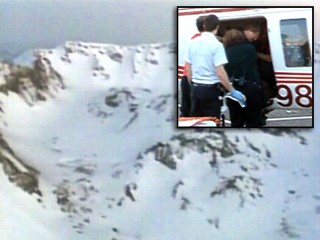An experienced snowmobiler, John Slemp, 52, of Damascus, Ore., miraculously survived a 1,500-foot plummet into the crater of Mt. St. Helens. He is the first person ever to fall into the crater.

On Saturday, Slemp, his son Jared and a family friend took their snowmobiles up to the crater's rim, where John and Jared parked their vehicles, then crawled on their bellies to peer over the cornice — a dangerous overhanging shelf of snow at the crest of a mountain — into the crater itself.
The cornice broke loose and Slemp dropped about 150 feet. His son began to slide down with him until their friend grabbed him and pulled him back to safety. The elder Slemp landed on a snow bank, but when he stood to climb back up the crater, the shelf of snow crumbled beneath him and he tumbled about 1,300 feet further down the crater, riding a tidal wave of avalanche debris on his hands and knees.
At 5:20 p.m. PT, the sheriff's office received a phone call that a man had fallen off the crater rim but was up and moving around.
"I'm not surprised," Undersheriff Dave Cox said. "There was an avalanche warning in effect and the weather conditions were such that, for that elevation, the snow was unstable. There were high temperatures, which means the snow was starting to melt ... [Slemp] just happened to be the impetus that caused that cornice to give way."
The coordinator of the rescue, Chief Tom McDowell, director of North Country emergency medical service, said Slemp first made a vertical drop of about 100 to 200 feet, then hit a snow bank and tumbled until the crater leveled out.
"We've always anticipated anyone falls off the crater rim is not gonna survive," McDowell said.
But Slemp was wearing a heavy snowmobile suit as well as a helmet and heavy boots, and he happened to fall in an area without craggy crevices or boulders which could have killed him.
"[He] picked a great place to do this," Gary Kapezynski, the training coordinator for the volcano rescue team, said. "This was one of two places at the crater which were snow covered and there were very few cliffs ... if he'd have gone off in other places, I don't think he would have made it."
The two men at the top of the crater did not call rescuers themselves. Stuck there without a cell phone, they were equipped with only a family radio service walkie-talkie, which is usually only supposed to work within a range of a couple miles. According to McDowell, the walkie-talkie managed to randomly pick up the signal of a family of campers in Mossy Rock, a city about 20 miles away.
"[The camper] was the one who called the sheriff's office. He maintained contact with the people left on the crater rim, and he would relay information back and forth with me," McDowell said, "'Fortuitous' would be a good word to describe this."
By communicating through the camper, the rescuers knew that Slemp was fully conscious and even walking around.
McDowell dispatched a helicopter with two rescuers and equipment, and as the helicopter flew over the crater, the rescuers saw Slemp standing up and waving.
The helicopter descended about 1,500 feet into the crater, where the pilot performed what is called a one-skid landing — which is not actually a full landing but a tricky hover involving only a single part of the helicopter touching down.
"You hover with one skid pointed in the snow with very little clearance and [the pilot] was able to do that, let Will get out and get to the patient," Kapezynski said.
To pick up the rescuer and Slemp, the pilot "then [did] the same thing to go back in."
Slemp was pretty banged up but he was healthy enough to scramble down and get into the helicopter. His leg was splinted and the rescuers checked him out as the helicopter flew back.
The rescue effort was swift and wrapped up in 2.5 hours, by about 7:30 p.m. PT.
Cox said that injuries on Mt. St. Helens are fairly common. "We have injuries on the mountain just about yearly from people trying to climb ... you get people who are 'day hikers' who think it's just a stroll up to the crater rim, but it's still a fairly technical mountain to climb."
As Slemp left the crater in the rescue helicopter, his son and friend left the crater rim to return home in the car they drove in. Slemp appeared to have one more thing on his mind, and he made a request of his rescuers.
"Did you tell those guys that the car keys are in the snowmobile, parked at the top of Mt. St. Helens?" he asked.
Slemp was taken to Yacolt, Wash., for medical care, and transferred to Legacy Emanuel Hospital in Portland, Ore. The hospital did not return calls inquiring about Slemp's condition, but Slemp's brother-in-law Randy Fairley told ABC News that, to his knowledge, Slemp was recovering.
Original here
No comments:
Post a Comment